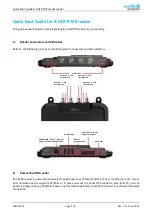
10/06
V200-18-E2B
S n a p - i n I / O M o d u l e
Unitronics
3
Wiring
Do not touch live wires.
Unused pins should not be connected. Ignoring this directive may damage the device.
Do not connect the ‘Neutral’ or ‘Line’ signal of the 110/220VAC to the device’s 0V pin.
Double-check all wiring before turning on the power supply.
Wiring Procedures
Use crimp terminals for wiring; use 26-12 AWG wire (0.13 mm
2
–3.31 mm
2
) for all wiring purposes.
1.
Strip the wire to a length of 7±0.5mm (0.250–0.300 inches).
2.
Unscrew the terminal to its widest position before inserting a wire.
3.
Insert the wire completely into the terminal to ensure that a proper connection can be made.
4.
Tighten enough to keep the wire from pulling free.
To avoid damaging the wire, do not exceed a maximum torque of 0.5 N·m (5 kgf·m).
Do not use tin, solder, or any other substance on stripped wire that might cause the wire strand to break.
Install at maximum distance from high-voltage cables and power equipment.
I/O Wiring—General
Input or output cables should not be run through the same multi-core cable or share the same wire.
Allow for voltage drop and noise interference with input lines used over an extended distance.
Use wire that is properly sized for the load.
Digital Inputs
Each group of 8 inputs has two common signals. Each group can be used as either pnp (source) or npn (sink),
when appropriately wired as shown in the following figures.
Inputs I0 and I2 can be used as normal digital inputs, as high-speed counters, or as part of a shaft encoder.
Inputs I1 and I3 can be used as normal digital inputs, as high-speed counter resets, or as part of a shaft
encoder.
The common signals of each group are internally shorted on each connector.




























